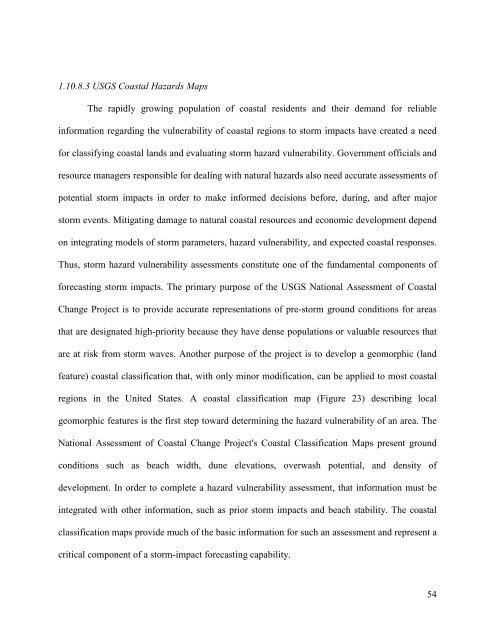1 1.10 Application of estuarine and coastal classifications in marine ...
1 1.10 Application of estuarine and coastal classifications in marine ...
1 1.10 Application of estuarine and coastal classifications in marine ...
You also want an ePaper? Increase the reach of your titles
YUMPU automatically turns print PDFs into web optimized ePapers that Google loves.
<strong>1.10</strong>.8.3 USGS Coastal Hazards Maps<br />
The rapidly grow<strong>in</strong>g population <strong>of</strong> <strong>coastal</strong> residents <strong>and</strong> their dem<strong>and</strong> for reliable<br />
<strong>in</strong>formation regard<strong>in</strong>g the vulnerability <strong>of</strong> <strong>coastal</strong> regions to storm impacts have created a need<br />
for classify<strong>in</strong>g <strong>coastal</strong> l<strong>and</strong>s <strong>and</strong> evaluat<strong>in</strong>g storm hazard vulnerability. Government <strong>of</strong>ficials <strong>and</strong><br />
resource managers responsible for deal<strong>in</strong>g with natural hazards also need accurate assessments <strong>of</strong><br />
potential storm impacts <strong>in</strong> order to make <strong>in</strong>formed decisions before, dur<strong>in</strong>g, <strong>and</strong> after major<br />
storm events. Mitigat<strong>in</strong>g damage to natural <strong>coastal</strong> resources <strong>and</strong> economic development depend<br />
on <strong>in</strong>tegrat<strong>in</strong>g models <strong>of</strong> storm parameters, hazard vulnerability, <strong>and</strong> expected <strong>coastal</strong> responses.<br />
Thus, storm hazard vulnerability assessments constitute one <strong>of</strong> the fundamental components <strong>of</strong><br />
forecast<strong>in</strong>g storm impacts. The primary purpose <strong>of</strong> the USGS National Assessment <strong>of</strong> Coastal<br />
Change Project is to provide accurate representations <strong>of</strong> pre-storm ground conditions for areas<br />
that are designated high-priority because they have dense populations or valuable resources that<br />
are at risk from storm waves. Another purpose <strong>of</strong> the project is to develop a geomorphic (l<strong>and</strong><br />
feature) <strong>coastal</strong> classification that, with only m<strong>in</strong>or modification, can be applied to most <strong>coastal</strong><br />
regions <strong>in</strong> the United States. A <strong>coastal</strong> classification map (Figure 23) describ<strong>in</strong>g local<br />
geomorphic features is the first step toward determ<strong>in</strong><strong>in</strong>g the hazard vulnerability <strong>of</strong> an area. The<br />
National Assessment <strong>of</strong> Coastal Change Project's Coastal Classification Maps present ground<br />
conditions such as beach width, dune elevations, overwash potential, <strong>and</strong> density <strong>of</strong><br />
development. In order to complete a hazard vulnerability assessment, that <strong>in</strong>formation must be<br />
<strong>in</strong>tegrated with other <strong>in</strong>formation, such as prior storm impacts <strong>and</strong> beach stability. The <strong>coastal</strong><br />
classification maps provide much <strong>of</strong> the basic <strong>in</strong>formation for such an assessment <strong>and</strong> represent a<br />
critical component <strong>of</strong> a storm-impact forecast<strong>in</strong>g capability.<br />
54
















